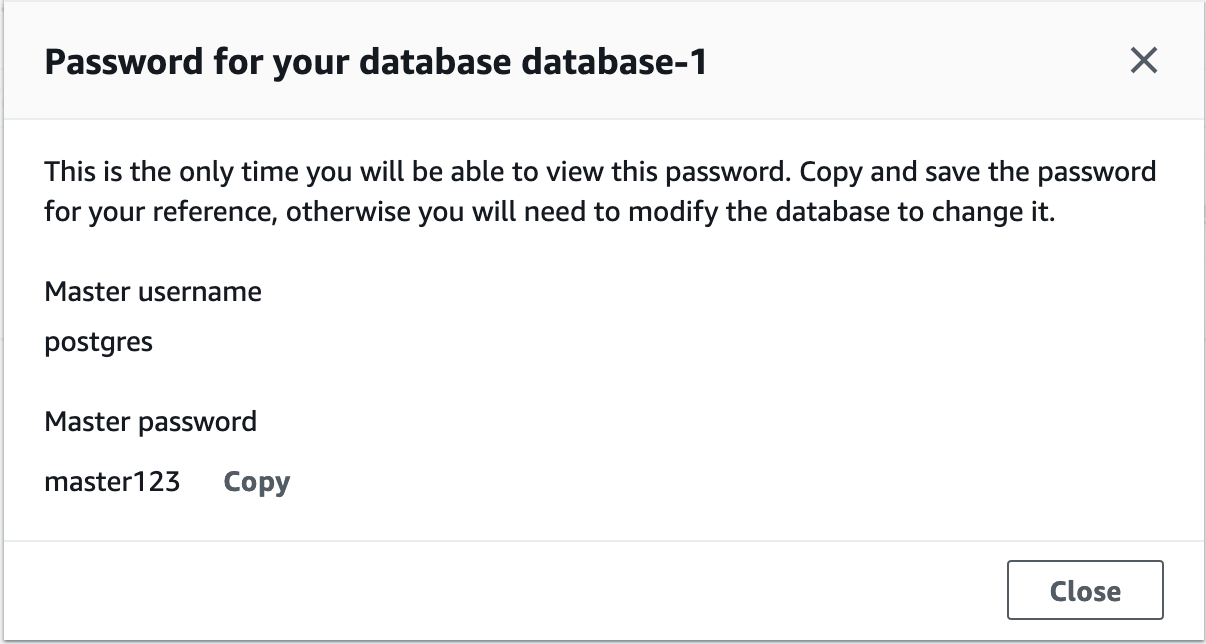

- #Aws postgresql 10 how to#
- #Aws postgresql 10 install#
- #Aws postgresql 10 software#
- #Aws postgresql 10 password#
- #Aws postgresql 10 download#
Now we can run PostgreSQL 10! To do so, run the following command from you In order to make our setup easier, we are going to create aĬalled " pgnetwork" that will connect our PostgreSQL 10 and pgAdmin 4Ĭontainers: docker network create -driver bridge pgnetwork However, by default, the Docker bridge network does not supportĪutomatically discovering other containers on the network. PgAdmin 4 container, so the default bridge network sounds ideal for our these We will need for our PostgreSQL 10 container to be able to communicate with your
#Aws postgresql 10 password#
The password for the "postgres" user in your database instance, which is the root user. This user will have access to PG_DATABASE The username of the default user in the database instance. The name of the default database to create in the database instance. The password for the PG_PRIMARY_USER in your database instance. Sets the username of the superuser for your database instance. Other options include "replica" for creating a read-only instance, as well as "set" for creating a StatefulSet in a Kubernetes cluster
#Aws postgresql 10 how to#
What do all of these settings do? SettingĪ parameter just for crunchy-postgres that determines how to setup this PostgreSQL instance. Using your favorite textĮditor, create a file in the postgres directory called called pg-env.list and We will create one volume for our PostgreSQL 10 environment: docker volume create -driver local -name=pgvolumeĪs mentioned mentioned earlier, we need to pass in some settings to properlyĬonfigure our Docker container to run PostgreSQL. Now, we need to create a folder to store the data for our PostgreSQL instance.īy default, Docker containers do not persist data beyond the lifecycle of a What I did on my computer: mkdir postgres Let's create a directory on your computer to work from. To help you optimize how you run your database.

Image, which uses the community version of PostgreSQL and passes in several That require different PostgreSQL usernames and passwords to access each For example, you may want to create several docker containers Images allow you to pass in variables in order to configure settingsĭynamically, which is useful if you want to deploy your containers across Snapshot of the filesystem of the application you want to run. We need to get an image of PostgreSQL in order to run a container. There areĪ few things we need to do before we can get PostgreSQL up and running.
#Aws postgresql 10 install#
Dockerįrom the URL below, or use your favorite package manager to install Docker onto Isolated instances of applications with all of their dependencies. Source containerization platform, which allows developers to create and run In order for this recipe to work, you need to be usingĭocker.
#Aws postgresql 10 download#
The Detailed guide Part 1: Download Docker Run the following commands in your terminal: tl dr: Quick setup for PostgreSQL 10 & pgAdmin 4 1. To get up and running, the tl dr guide is just below. Some light on how to work with Docker and PostgreSQL. So I wrote a detailed guide explaining each part of the process to help shed While going through this process, I was also learning how to better use Docker, One of our engineers gave me a recipe to setup While I was trying to find things to experiment with using Docker,
#Aws postgresql 10 software#
The open source software ecosystem around PostgreSQL is as robust as theĭatabase itself, but sometimes it can be hard for people new to PostgreSQL, andĮven some seasoned veterans, to get all of the software dependencies for theirĭevelopment environment setup on their computers.Īt Crunchy Data, we obsess on making things asĮasy as possible for people to get software up and running, regardless of the Please click here to view this show’s transcript.Easy PostgreSQL 12 and pgAdmin 4 Setup with Docker! Thanks to We Edit Podcasts for partnering with SE Daily. Software Engineering Daily listeners can go to to get 15% off the first three months of audio editing and transcription services with code: SED. We discuss how Neon scales Postgres, how it saves cost and the engineering that makes it possible. Today, we spoke with Nikita Shamgunov of Neon. It separates storage and compute and substitutes the PostgreSQL storage layer by redistributing data across a cluster of nodes. Neon is a serverless open-source alternative to AWS Aurora Postgres.

Postgres-based databases are widespread and are used by a variety of organizations, from Reddit to the International Space Station, and Postgres databases are a common offering from cloud providers such as AWS, Alibaba Cloud, and Heroku. PostgreSQL is a free and open-source relational database management system.


 0 kommentar(er)
0 kommentar(er)
